"When I had satisfied myself that no star of that kind had ever shone before, I was led into such perplexity by the unbelievability of the thing that I began to doubt the faith of my own eyes." -Tycho Brahe
Supernovae are the most spectacular death-knells of the largest stars in our Universe. Nearly all stars burn light elements into heavier ones, releasing energy through the incredible process of nuclear fusion.
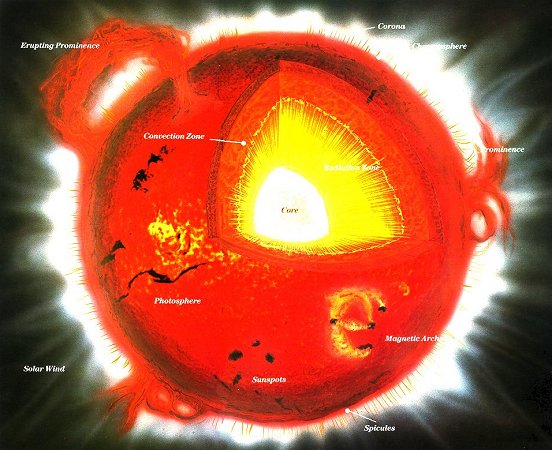
But all stars eventually run out of this fuel. For our Sun, we've got about another 6 billion years left. But the more massive your star, the faster it burns through its fuel. Whenever you have a star more than about four times as massive as our Sun, it will exhaust all of its fuel in well under one billion years. (In fact, for the largest stars, they live under 100,000 years!)
But what happens to these supermassive stars when they do run out of fuel? Do they just whimper and die?

It's like getting to the fireworks show, and only catching the last, extinguishing flames of what was once a beautiful show.
Now, we can look with X-ray or infrared eyes, and see some interesting features.
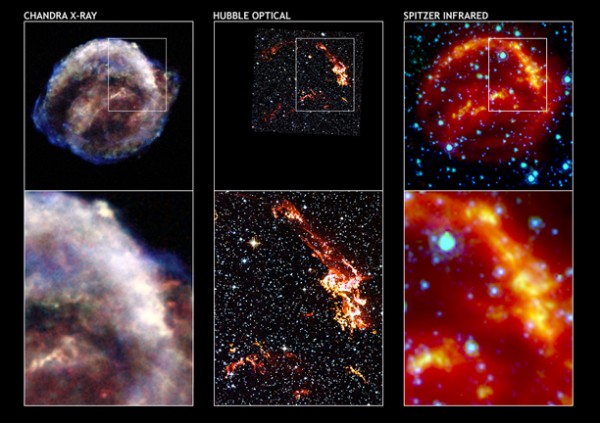
But it just isn't the same as seeing what this was like, visually, shortly after the explosion. Thankfully for all astronomers and fans of outer space, we detect supernovae in other galaxies far more frequently than every few hundred years.
One such galaxy -- the Large Magellanic Cloud -- is only 160,000 light years away, and has a lot of huge young stars, that are happy to die and explode before our very eyes.
In this composite image of an optical, ground-based image and the Chandra X-ray observatory, we can detect a recent supernova remnant: SNR 0509. Here's a video of the "light echo" of the explosion, courtesy of Chandra.
Let's take a look, and click for the giant, 1.4 MB image.
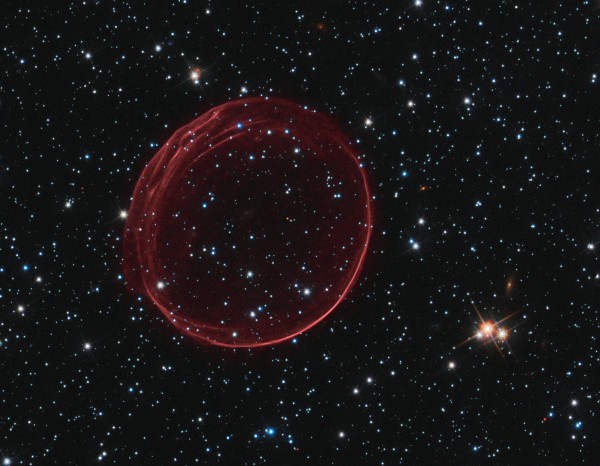
Is this really a giant bauble of gas associated with the supernova? Well, we can combine the Hubble and Chandra images to know for certain.
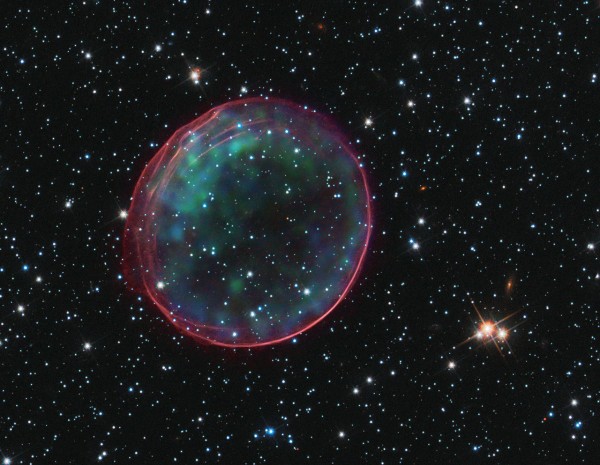
It's amazing, really, the resolution that Hubble can still get! And, of course, we can examine some amazing details if we poke around inside the bubble itself! Such as...
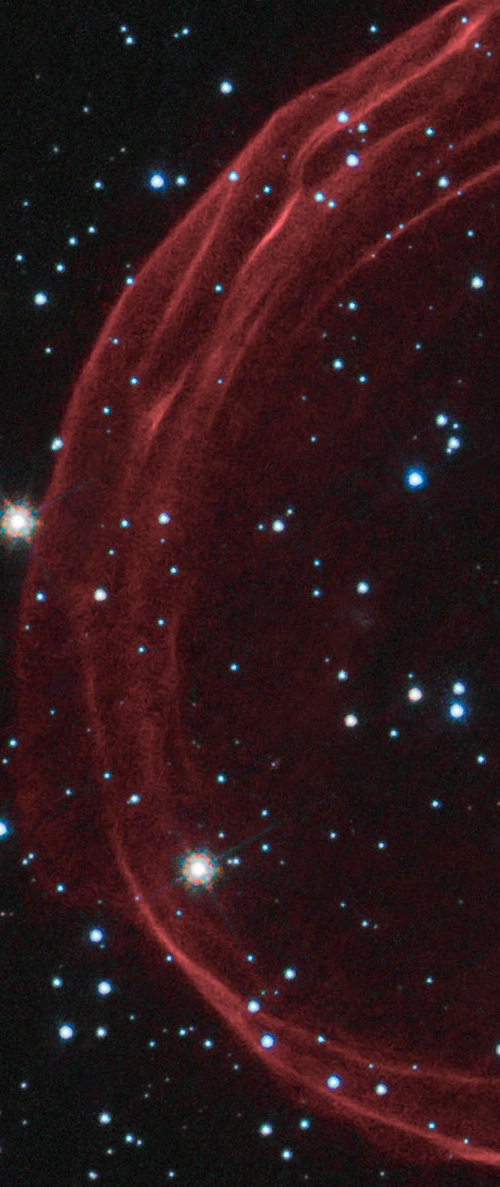
Giant filaments of hot gas, literally stretching light years across the sky! The bubble, in fact, is a whopping 23 light years in diameter. (And to get an appreciation of Hubble's resolution, remember, this image is of a single, dead star 160,000 light years away.)
What else?

A dim side, where the hot, expanding gas is far less dense than elsewhere. Unlike Tuesday's images, this bubble is so bright that the exposure time is too small to see distant galaxies; otherwise, the brightness of the stars would overexpose this photograph! All I've been able to find, in the entire image, is one.
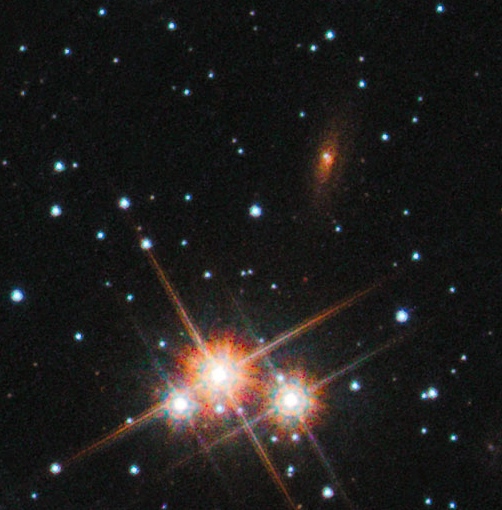
What we mostly get, instead, is a cluster of (apparently) super-bright stars from our intervening galaxy, and what appear to be normal stars from the LMC itself. So thanks to you Hubble, for the beautiful holiday ornament. To all my Southern Hemisphere friends: this one's for you!

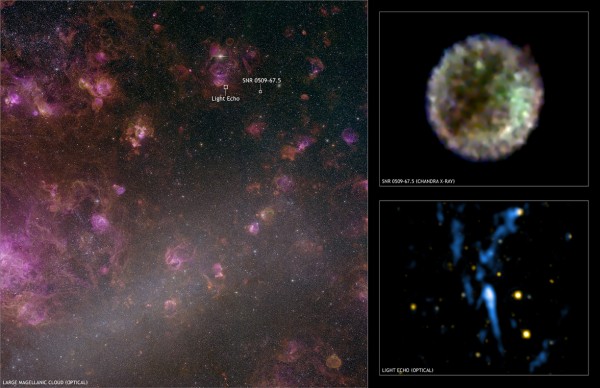
" If we look at the last supernova visible in the Earth's night sky to humans, we have to go all the way back to 1604."
Umm... Don't you mean 1989
wow, I must need more coffee, was referring to SN1987A.
SN1987A was in the LMC. But it reached an apparent magnitude of 3.03 in May 1987.
If something is said to be x amount of light years across. Then we can assume the depth could also be measured in light years. If something is x amount of light years distance away from earth, then are we measuring it from the front of the object? How do we get flat images of something hundreds of light years deep. Wouldn't the light from the far side of the object be much, much older than the front side of the object so therefore it would appear to have changed. I'm thinking some weird optical illusions would be happening. I'm just a little confused.
Mektubat-ı Rabbaninin 3.cildinde, (Sen olmasaydın Cenneti yaratmazdım), (O olmasaydı kâinatı yaratmaz, rububiyetimi izhar etmezdim) kudsi hadisleri de bildirilmektedir.
Miracda Allahü teâlâ, Peygamber efendimize, (Senden baÅka her Åeyi senin için yarattım) buyurunca, Resulullah sallallahü aleyhi ve sellem de, (Ben de senden baÅka her Åeyi senin için terk ettim) dedi. (Mirat-i kâinat)
@alex -- You're right, but as long as an object expands slowly compared to the speed of light, the near and far sides are at about the same stage of development. Suppose a supernova remnant is 1000 years old, and expanding at 5% of the speed of light (they expand somewhat slower than that, generally). Then by now it's 50 light years across (which is very big!), but the timing difference between the near and far side is only 50 years, out of 1000.
With cosmology, the light-travel time effect is key -- it's what makes it possible to look back in time, as it were.
I get it. but... Anyway thanks John.
SusuzluÄun sadece su içerek giderilebileceÄini açıklayan Prof. Dr. Ä°brahim Adnan SaraçoÄlu suyun yerini hiçbirÅeyin dolduramayacaÄını açıklayarak Åu açıklamalarda bulundu: âBazı insanlar, susuzluklarını daha saÄlıklıdır diye düÅünerek bitkisel çay veya taze sıkılmıŠmeyve sularıyla geçirmeye çalıÅırlar
Bu yanlıŠbir uygulamadır. Vücudunuzu meyve sularıyla yıkayabilir misiniz? Ãyleyse susadıÄınızda da susuzluÄunuzu sadece ve sadece doÄal mineral içeren suyla gidermeniz daha doÄru bir karar olacaktır. SusuzluÄunuzu suyun dıÅında herhangi bir içecekle karÅılamaya kalkarsanız vücudunuzun su ihtiyacı kesinlikle giderilmez. Ayrıca yemeklerde su haricinde içilen tüm sıvılar açlık duygusunu daha fazla tetikleyerek yemek yerken doyma duygusunu geciktirici etki gösterir
Kulüp baÅkanlarının Türk Telekom Arenaâyı ziyareti öncesinde statta iÅçi olarak çalıÅan iki kiÅinin Galatasaray ve Fenerbahçe atkılarını yan yana açması krize neden oldu.
Ä°ki kiÅi dostluk örneÄi sergilemek isterken statta çalıÅan bir güvenlik görevlisi iÅçinin elindeki Fenerbahçe yazılı atkıyı çekerek aldı.
If something is said to be x amount of light years across. Then we can assume the depth could also be measured in light years. If something is x amount of light years distance away from earth, then are we measuring it from the front of the object? How do we get flat images of something hundreds of light years deep.
yes postinga holidayturkeyy hii bodrumhotel